Radio frequency identification transponder antenna
a radio frequency identification and transponder chip technology, applied in the field of radio frequency identification transponders, can solve the problems of complex process and fabrication, high cost, and substantial complexity of the relatively large structure, and achieve the effect of low input impedance, low resistance, and simplified matching of the antenna base impedance to the input impedance of the assembled transponder chip
- Summary
- Abstract
- Description
- Claims
- Application Information
AI Technical Summary
Benefits of technology
Problems solved by technology
Method used
Image
Examples
Embodiment Construction
[0043]FIG. 1 schematically depicts a RFID transponder provided with a microchip 1, an impedance-matching structure 2 and a resonant structure 3. The components are mounted on a substrate 4 which may be a flexible material such as, for example, a copper plated polyethylene terephthalate film. The impedance-matching structure has been fabricated by an etching process and is structured as a rectangular loop.
[0044] The resonant structure 3 is of an M-shaped structure and in accordance with the invention, it is not galvanically connected to the loop structure 2 including the microchip 1.
[0045] For the sake of clarity and convenience like elements will hereafter be identified by like reference numerals.
[0046]FIG. 2 schematically shows a RFID transponder in accordance with the invention with the impedance-matching structure 2 being configured as a substantially square loop. The resonant structure 3 is formed by two parallel spaced strip structures accommodating between them loop structu...
PUM
 Login to View More
Login to View More Abstract
Description
Claims
Application Information
 Login to View More
Login to View More - R&D
- Intellectual Property
- Life Sciences
- Materials
- Tech Scout
- Unparalleled Data Quality
- Higher Quality Content
- 60% Fewer Hallucinations
Browse by: Latest US Patents, China's latest patents, Technical Efficacy Thesaurus, Application Domain, Technology Topic, Popular Technical Reports.
© 2025 PatSnap. All rights reserved.Legal|Privacy policy|Modern Slavery Act Transparency Statement|Sitemap|About US| Contact US: help@patsnap.com



